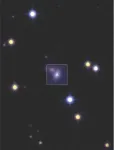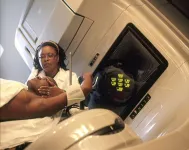(Press-News.org) WASHINGTON --- Researchers at Georgetown University’s Lombardi Comprehensive Cancer Center and colleagues who have been exploring the complexities of biochemical pathways involved in cancer development have found that a form of glucose, a type of sugar, is intricately linked to a pathway used to build DNA molecules. When this pathway is overactive, it can lead to cancer and resistance to chemoradiotherapy.
The findings appear June 12, 2023, in Nature Chemical Biology.
“For a good while, my lab has been exploring cell signaling and DNA transcription mechanisms by which cellular metabolism changes in response to environmental and genetic cues, with the goal of designing strategies to treat cancer and other diseases,” says Huadong Pei, PhD, associate professor in the Department of Oncology at Georgetown Lombardi and a corresponding author of the publication. “Knowing that cancer cells usually grow quickly and require more glucose than normal cells to reprogram their metabolism has been key to jumpstarting this latest research effort in the hope that we can gain a better understanding of how we can fight cancer at the cellular, or even subcellular level.”
Pei’s current research effort started when he and his colleagues looked at how nutrients that cells gobble up to stay alive end up triggering modifications to proteins as a result of adding a sugar called O-linked β-N-acetylglucosamine (O-GlcNAc) to the protein. This dynamic and reversible modification is emerging as a key regulator of a number of different cellular processes. In a series of experiments in both the lab and in mice, the researchers were able to determine that there is an important enzyme involved in nucleotide synthesis, called phosphoribosyl pyrophosphate synthetase 1 (PRPS1), that is modified by O-G1cNAc. Targeting either the sugar or the enzyme could be key to affecting cancer outcomes, the researchers believe.
“Ultimately, we would like to be able to design drugs that target DNA nucleotide synthesis, which includes the modifications we’ve identified of adding a sugar to a protein and the catalyzing step acted on by the PRPS1 enzyme,” said Pei. “In particular, we’d like to develop drugs that can be used to make lung cancer more sensitive, or responsive, to radiotherapy and chemotherapy, as resistance to these therapies is still far too common. But there is still a long way to go, and many more experiments will be needed before we can even consider drug design.”
Meanwhile, the researchers next step is to start examining applications of their findings in animal models by using mice grafted with human lung cancer tissue to see if drugs targeting nucleotide synthesis sensitize lung cancer to radiotherapy and chemotherapy.
###
In addition to Huadong Pei, other authors at Georgetown include Lulu Chen, Qi Zhou, Yingge Li, Ziwen Xu, Junfeng Ma and Gary M. Kupfer. Pingfeng Zhang and Qibin Song are at the Renmin Hospital of Wuhan University, China; Wei Tan is at The University of Texas MD Anderson Cancer Center, Houston and Yanxin Pei is at the Children’s National Health System, Washington, DC.
This research was supported by NIH grants RO1-CA68135 and RO1-NS121243.
The authors declare no competing interests.
About Georgetown University’s Lombardi Comprehensive Cancer Center
Georgetown’s Lombardi Comprehensive Cancer Center is designated by the National Cancer Institute (NCI) as a comprehensive cancer center. A part of Georgetown University Medical Center, Georgetown Lombardi is the only comprehensive cancer center in the Washington D.C. area. It serves as the research engine for MedStar Health, Georgetown University’s clinical partner. Georgetown Lombardi is also an NCI recognized consortium with John Theurer Cancer Center/Hackensack Meridian Health in Bergen County, New Jersey. The consortium reflects an integrated cancer research enterprise with scientists and physician-researchers from both locations. Georgetown Lombardi seeks to improve the diagnosis, treatment, and prevention of cancer through innovative basic, translational and clinical research, patient care, community education and outreach to service communities throughout the Washington region, while its consortium member John Theurer Cancer Center/Hackensack Meridian Health serves communities in northern New Jersey. Georgetown Lombardi is a member of the NCI Community Oncology Research Program (UG1CA239758). Georgetown Lombardi is supported in part by a National Cancer Institute Cancer Center Support Grant (P30CA051008). Connect with Georgetown Lombardi on Facebook (Facebook.com/GeorgetownLombardi) and Twitter (@LombardiCancer).
END
Determining how a sugar molecule can affect cancer cell response to chemoradiotherapy
2023-06-12
ELSE PRESS RELEASES FROM THIS DATE:
Unhealthy neighborhood food environments are linked to poor birth weight outcomes in New York
2023-06-12
Higher neighborhood density of unhealthy retail food establishments was associated with a higher risk of delivering a baby that was large-for-gestational age, according to a new study at Columbia Mailman School of Public Health, while neighborhoods with a high density of healthy food retail establishments was linked with a lower risk of giving birth to a baby that was small-for-gestational age. Babies born either small- or large-for-gestational age, a measure of birth weight adjusted for length of pregnancy, are at greater risk for long term health complications, but until now little was known about how neighborhood characteristics including walkability and the ...
Astronomers discover supernova explosion through rare ‘cosmic magnifying glasses’
2023-06-12
According to Einstein’s general theory of relativity, time and space are fused together in a quantity known as spacetime. The theory suggests that massive objects, like a galaxy or galaxy clusters, can cause spacetime to curve. Gravitational lensing is a rare yet observable example of Einstein’s theory in action; the mass of a large celestial body can significantly bend light as it travels through spacetime, much like a magnifying lens. When light from a more distant light source passes by this lens, scientists can use the resulting visual distortions to view objects that would otherwise be too far away and too faint to be seen.
An ...
Study brings new understanding of multiple myeloma evolution
2023-06-12
HOUSTON – A new study by researchers at The University of Texas MD Anderson Cancer Center highlights novel insights into the evolution of multiple myeloma from precursor disease, which may help better identify patients likely to progress and develop new interventions.
Published today in Cancer Cell, the study integrates paired single-cell RNA sequencing and B cell receptor sequencing from 64 patients with multiple myeloma or precursor disease. The study achieved several notable milestones in the effort to better understand ...
Previously unknown material could revolutionize cancer treatment
2023-06-12
A new material, created at the little-explored intersection of organic and inorganic chemistry, could not only enable more powerful solar panels, but it could also usher in the next generation of cancer treatments.
Described in a Nature Chemistry journal paper published today, the composite is made of ultra-tiny silicon nanoparticles, and an organic element closely related to those used in OLED televisions. It is capable of increasing the speed with which two molecules can exchange energy, and of converting lower-energy light into higher-energy light.
Only a handful of laboratories ...
19-hour days for a billion years of Earth’s history: Study
2023-06-12
It's tough accomplishing everything we want to get done in a day. But it would have been even more difficult had we lived earlier in Earth's history.
Although we take the 24-hour day for granted, in Earth's deep past, days were even shorter.
Day length was shorter because the Moon was closer. "Over time, the Moon has stolen Earth's rotational energy to boost it into a higher orbit farther from Earth," said Ross Mitchell, geophysicist at the Institute of Geology and Geophysics of the Chinese Academy of Sciences and lead author of a new study published in Nature Geoscience.
"Most models of Earth's rotation predict that day length was consistently shorter ...
New method enables study of nano-sized particles
2023-06-12
Researchers at Karolinska Institutet have created a new method of studying the smallest bioparticles in the body. The study, which is published in Nature Biotechnology, has considerable scientific potential, such as in the development of more effective vaccines.
Circulating around the body are nanoparticles that affect it in one way or another. For example, there are lipoproteins that maintain cell metabolism, pathogenic viruses that cause many diseases and lipid nanoparticles that are used to carry drugs, like recent lipid nanoparticle-based mRNA vaccines.
However, ...
Unveiling quantum gravity: New results from IceCube and Fermi data
2023-06-12
In a study published in Nature Astronomy today, a team of researchers from the University of Naples “Federico II”, the University of Wroclaw, and the University of Bergen examined a quantum-gravity model of particle propagation in which the speed of ultrarelativistic particles decreases with rising energy. This effect is expected to be extremely small, proportional to the ratio between particle energy and the Planck scale, but when observing very distant astrophysical sources, it can accumulate to observable levels. The ...
State agencies grant nationwide access to ultrasound disinfectant from Parker Labs
2023-06-12
FAIRFIELD, NJ—Parker Laboratories Inc. has announced that the environmental protection and pesticide control agencies of all 50 states have authorized registration of Tristel DUO, an intermediate-level disinfecting foam for the cleaning and disinfection of general medical surfaces—including noninvasive ultrasound transducers and their related equipment.
Tristel DUO is manufactured and distributed for US markets by Parker Laboratories under an exclusive commercial partnership with UK-based infection prevention company Tristel plc. Parker Laboratories ...
Researchers: win up to $40K studying effects of lipoprotein(a) on cardiovascular disease, stroke risk
2023-06-12
DALLAS, June 12, 2023 — The American Heart Association, the world’s leading voluntary organization focused on heart and brain health, invites scientific researchers across the globe to compete in a new data challenge to better inform the scientific understanding of how lipoprotein(a) [Lp(a)] levels impact the risk of cardiovascular disease and stroke. The winning project is eligible to receive a $40,000 USD cash prize.
High levels of Lp(a) — a low-density lipoprotein variant containing a protein called apolipoprotein(a) ...
Revolutionizing cardiology: AI-based technology offers accurate analysis of cardiac disease
2023-06-12
(Toronto, June 12, 2023) – New research published in JMIR Cardio reveals the remarkable potential of artificial intelligence (AI) technology in analyzing coronary angiography, a common diagnostic procedure for coronary artery disease. Led by Dr In Tae Moon, the study conducted at Uijeongbu Eulji University Hospital in Korea showcases the power of AI-based quantitative coronary angiography (AI-QCA) in enhancing clinical decision-making.
The study compared AI-QCA to intravascular ultrasound (IVUS), to validate its performance. IVUS is ...






